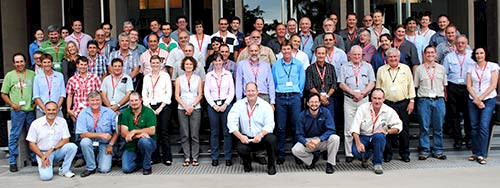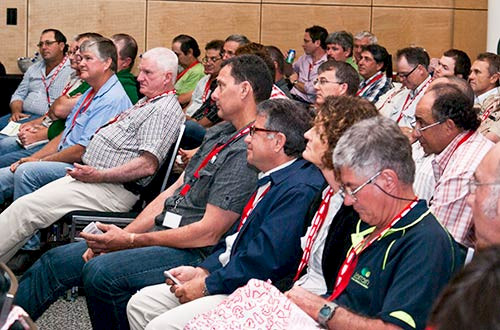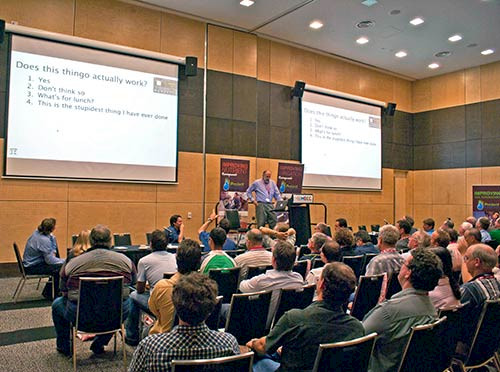Sugar, Coca-Cola, WWF, clickers and scorecards
Bill Dennison ·On May 9, I attended a Project Catalyst Workshop at the Mackay Entertainment and Convention Centre along the Central Queensland coast. The workshop was organized by Will Higham and his colleagues at Reef Catchments, and it included three dozen sugarcane growers from three sugar producing regions within the Great Barrier Reef catchment; Mackay/Whitsunday/Isaac region, Burdekin region and the Wet Tropics. In addition the sugarcane growers, Project Catalyst is operated as a partnership between sugarcane producers, Reef Catchments, WWF and Coca-Cola with the intent of reducing runoff of sediments, nutrients and toxicants into the Great Barrier Reef.

Robert Quirk, a sugarcane grower from the Tweed River in northern New South Wales was an invited speaker. Years ago, Robert had come for a visit to Chesapeake Bay as part of his Churchill fellowship and we visited the Pokomoke River with Dr. Del Fanning from the University of Maryland, College Park. The reason for the visit to the mouth of the Pokomoke River was the presence of acid sulfate soils, which were a result of navigational channel dredging at the mouth of the Pokomoke River to allow barges to transport Eastern shore wood chips to the western shore. Subtidal hydric sediments relocated to terrestrial uplands by dredging become oxidized, which facilitates the conversion of reduced sulfitic compounds into sulfuric acid. The acidic leachate mobilizes heavy metals which are precipitated out into concreations when neutralized by seawater. Since the mouth of the Pokomoke River was the epicenter of the Pfiesteria blooms in the late 1990s, I wonder if the bioavavailability of trace metals as a result of dredging had something to do with the onset of the Pfiesteria blooms. Since Robert's cane farm is a meter below sea level, he also deals with acid sulfate soils. The use of neutralizing agents (e.g., lime) is often used.
Robert talked about the global Bonsucro non government organization which promotes sustainable practices for growing sugarcane using transparent and verifiable criteria. He provided global examples of sugarcane production using labor intensive vs. highly mechanized approaches. Robert called for verifiable data and transparent tracking systems so that all sugarcane growers are rated rigorously and fairly.

Project Catalyst is interested in developing a scorecard for rating the various innovative practices being developed for the sugarcane industry. So after hearing about some of the innovations that have been developed, we facilitated a session on developing the scorecard. In order to obtain truly representative feedback, we decided to employ the use of 'clicker' technology used for teaching at universities. The University of Queensland allowed us to borrow a set of clickers and a receiver for my laptop. At the first session, we passed out a clicker for each cane grower and asked them a series of questions about each of five categories used to rate the different practices. They were able to instantly rate each category and the collated results were displayed on the screen for all to see. From this initial feedback we progressed the scorecard during the afternoon session and we developed a rating system using feedback from cane growers and the technical support crew for two of the practices that were elucidated in the cane grower sessions.

There were several advantages of using clickers in this setting. 1) The participatory engagement that the clickers allowed was appreciated by the cane growers. They remarked about how they are used to being active and sitting still listening to talks was not something they enjoyed, so having something to do (voting with clickers) was appreciated. 2) We were able to obtain 100% participation, as not just the vocal participants were voting. 3) The novelty of having a relatively high tech device entrusted to them and having their votes recorded and displayed was different than they had ever experienced. 4) By obtaining quantitative feedback in real time, we were able to modify the approach and get feedback on the next iteration. We only had direct access to the entire group for a limited amount of time, so it was important to obtain rapid feedback and turnaround.
The evening festivities were very nicely done. We had a reception at the Art Space Mackay which had a nice glassworks exhibit and various other paintings and sculptures. A very nice video about Reef Catchments was launched and the chair of Reef Catchments, Royce Bishop, talked about the exciting things that they were doing. Following the reception, we walked over to the connection center, where a wonderful venue was waiting. The decorations included a bundle of sugarcane shoots in the center of each table surrounded by sea turtle bean bags. The food and drinks were particularly nice, and the sugarcane growers are a sociable and entertaining group. The CEO of Coca-Cola Pacific, Gareth Edgecombe, came up from Sydney and presented a video about Project Catalyst that they had produced and spoke passionately about their involvement. Rob Cocco, CEO of Reef Catchments was the master of ceremonies and he awarded a couple of cane growers free accommodation at different reef resorts, which were donated by the resorts. The after dinner speaker was Rob Gell, National President of Greening Australia. Rob had a very slick Keynote presentation with video, animations and great visuals to talk about weather and climate change.

One of the things that I learned about sugarcane growers was that they are FUN. They had a great sense of humor, and I believe there were more laughs per PowerPoint than I have ever experienced in a workshop. At dinner, I was introduced to several of the cane growers wives who were very engaging as well. I felt as though I was being welcomed into their families, which was reinforced the following day when our field trip ended at Gerry Deguara's home and his wife Barbara served us home made scones with tea and their personable sons showed us around the farm.
About the author
Bill Dennison

Dr. Bill Dennison is a Professor of Marine Science and Vice President for Science Application at the University of Maryland Center for Environmental Science.
Next Post > Reasons to be optimistic about sugarcane impacts on the Great Barrier Reef
Comments
-
John Tyler 11 years ago
My view on the acidic leachate and blooms associated with areas around the mouth of the Pokomoke River and whether trace metals might be the cause, is that it would be interesting to see whether those organisms were encouraged to grow by a lab test using seawater plus the diluted leachate in similar conditions. There might have been an effect but to know whether these organisms were deficient in those trace metals and hence would grow faster with additional trace metal in solution, can possibly be assessed by some experimentation in the lab?

